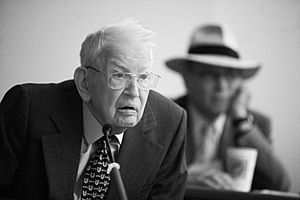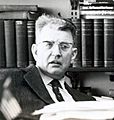Ronald Coase facts for kids
Quick facts for kids
Ronald Coase
|
|
|---|---|
 |
|
| Born |
Ronald Harry Coase
29 December 1910 Willesden, London, England
|
| Died | 2 September 2013 (aged 102) Chicago, Illinois, U.S.
|
| Nationality | British |
| Institution | University of Dundee London School of Economics University of Chicago University of Virginia University at Buffalo |
| Field | Law and economics |
| School or tradition |
New institutional economics Chicago School of Economics |
| Alma mater | London School of Economics (BA) University of London (DSc) University of Chicago |
| Contributions | Coase theorem Analysis of transaction costs Coase conjecture |
| Awards | Nobel Prize in Economics (1991) |
| Information at IDEAS / RePEc | |
Ronald Harry Coase (born December 29, 1910 – died September 2, 2013) was a famous British economist and writer. He studied at the London School of Economics, earning his first degree in 1932 and later a PhD. Coase taught there until 1951.
Later, he became a professor at the University of Chicago Law School in 1964 and stayed there for the rest of his life. In 1991, he won the Nobel Memorial Prize in Economic Sciences for his important ideas.
Coase believed that economists should study how real-world wealth is created. He thought they should look at how society, history, culture, and politics affect the economy. He felt that studying only "price theory" or made-up markets was not enough. Instead, economists should focus on how real markets work.
He showed why companies, or "firms," exist. They help manage the costs of doing business in a marketplace. Coase is most famous for two articles. "The Nature of the Firm" (1937) introduced the idea of transaction costs. These are the costs of making a deal or doing business. This idea helped explain why companies form and how big they get.
His second famous article, "The Problem of Social Cost" (1960), suggested a big idea. It said that if people clearly owned things (called property rights), they could solve problems like pollution. This could happen even without government help, as long as the costs of making a deal were low. This idea is known as the Coase theorem. Coase's ideas about transaction costs are still very important in how we understand how organizations work today.
Contents
About Ronald Coase
Ronald Harry Coase was born in Willesden, a part of London, on December 29, 1910. His parents, Henry Joseph Coase and Rosalie Elizabeth Coase, both worked as telegraphists for the post office.
When he was a child, Coase had weak legs and had to wear special leg braces. Because of this, he went to a school for children with physical challenges. At age 12, he earned a scholarship to Kilburn Grammar School. There, he prepared for university exams from 1927 to 1929.
Coase continued his studies at the London School of Economics, which is part of the University of London. He earned a degree in commerce in 1932. During his studies, he received a scholarship that allowed him to visit the University of Chicago in 1931–1932.
From 1932 to 1934, Coase taught at the Dundee School of Economics. Then, he taught at the University of Liverpool from 1934 to 1935. After that, he returned to the London School of Economics and taught there until 1951. In 1951, he earned his doctorate in economics from the University of London.
Coase moved to the United States in the 1950s but kept his British citizenship. He worked at the University at Buffalo. In 1958, he moved to the University of Virginia. Finally, in 1964, Coase settled at the University of Chicago. There, he helped edit the Journal of Law and Economics. He won the Nobel Prize in Economics in 1991.
Close to his 100th birthday, Coase was writing a book about the growth of the economies in China and Vietnam. This book, "How China Became Capitalist" (2012), was written with Ning Wang. In May 2012, he received an honorary degree from the University at Buffalo.
Coase married Marion Ruth Hartung in England on August 7, 1937. They were married for 75 years until she passed away in 2012. Ronald Coase himself died in Chicago on September 2, 2013, at 102 years old. Many people praised his work, calling him one of the most important economists in the world.
Key Ideas in Economics
Understanding "The Nature of the Firm"
In his important essay "The Nature of the Firm" (1937), Coase asked a simple question. Why do we have large companies, or "firms," instead of everyone working for themselves and making deals with each other? He wondered why firms exist at all.
Coase looked at why a business owner might hire people instead of paying other independent people for every single task. At the time, most economists thought it was always cheaper to pay someone else for a specific job. This was because markets were seen as very "efficient."
However, Coase pointed out that using the market has many hidden "transaction costs." These are more than just the price of a product or service. They include:
- The cost of finding information.
- The cost of bargaining and making a deal.
- The cost of keeping business secrets safe.
- The cost of making sure deals are followed.
These costs can make it more expensive to get something from another company. So, Coase argued that firms form to do these tasks themselves. By doing things "in-house," firms can avoid these extra costs. This idea showed that markets and firms are different ways to organize economic activities.
But there's a limit to how big a firm can get. Coase noted that as a firm grows, its costs of managing things go up. Managers might also start making more mistakes. These problems make it harder for a firm to keep growing forever.
Coase believed that a firm's size depends on finding the right balance. It's about balancing the benefits of avoiding transaction costs with the rising costs of managing a very large company.
A firm will tend to be larger if:
- It's cheaper to organize things inside the firm.
- Managers are less likely to make mistakes as the firm grows.
- The cost of getting resources for larger firms is lower.
The costs of organizing things increase if tasks are spread out or very different. This helps explain why firms might be in different places or do different kinds of work. New technologies, like telephones or cheap air travel, can make it easier to organize things over distance. This can allow firms to become even larger.
Solving "The Problem of Social Cost"
When Coase published his article "The Federal Communications Commission" in 1959, some economists at the University of Chicago disagreed with him. They thought his ideas went against what another economist, A. C. Pigou, had said.
In 1960, Coase presented his paper "The Problem of Social Cost" at a meeting in Chicago. He talked to about twenty leading economists, including George Stigler and Milton Friedman. Coase was able to convince them that his ideas were correct. This meeting is seen as a very important moment in the history of "Law and Economics." Coase joined the Chicago faculty four years later.
Published in 1960, "The Problem of Social Cost" had a key idea. It said that it's not always clear who is to blame for problems like pollution. Coase gave an example of a rancher whose cattle wander onto a farmer's crops. If the rancher has to keep his cattle fenced in, he loses out. But if the cattle are free to roam, the farmer loses out.
Coase argued that if it's easy to make deals (meaning low transaction costs), it doesn't matter who initially owns the rights. The farmer and rancher will find the best solution. For example, if building a fence costs less than the crop damage, a fence will be built. Who pays for the fence depends on who has the property rights. If the farmer is responsible for the damage, they will pay for the fence.
So, Coase said that who gets the property rights first mainly affects who earns money or owns wealth. It doesn't affect whether the best economic outcome happens. But if making deals is difficult (high transaction costs), then who has the property rights at the start does matter for both fairness and efficiency.
This important idea became known as the Coase theorem, named by George Stigler.
Law and Economics Studies
Even though Coase was trained as an economist, he spent much of his career working in a law school. He was a key person in developing a field called "law and economics."
He saw this field as having two parts. The first part uses economic ideas to study how the legal system works. This is often called the "economic analysis of the law." The second part looks at how the legal system affects the economy. Coase said he was most interested in this second part.
Coase believed that the University of Chicago was the main place for studying law and economics.
The Coase Theorem Explained Simply
In the field of law and economics, the Coase theorem describes how efficient an economic outcome can be when there are "externalities." Externalities are effects that a person's actions have on others, like pollution.
The theorem says that if people can trade the right to create an externality, and if the costs of making a deal are low, then bargaining will lead to the best possible outcome. This happens no matter who started with the rights. In real life, it can be hard to bargain, or property rights might not be clear. These things can stop the Coase theorem from working perfectly. This important idea is usually credited to Coase.
The Coase Conjecture Explained Simply
Another important idea from Coase is the Coase conjecture. This is an informal argument that says companies that sell long-lasting goods, like cars or appliances, might not have much power over prices. This is because they can't promise not to lower their prices in the future. Buyers might just wait for a lower price.
Coase's Political Views
Coase shared that when he was young, he supported socialism.
Another scholar, Guido Calabresi, thought that Coase's focus on transaction costs in "The Nature of the Firm" came from his socialist beliefs. Coase himself said, "It is very difficult to know where one's ideas come from but for all I know he may well be right."
The Ronald Coase Institute
Coase was an advisor for the Ronald Coase Institute. This group helps research institutions and organizations. These are the laws, rules, customs, and norms that guide real economic systems. The institute especially supports young scholars from developing countries.
The Coase-Sandor Institute for Law and Economics
The University of Chicago Law School continues Ronald Coase's work through the Coase-Sandor Institute for Law and Economics. Each year, the Law School hosts the Coase Lecture. Ronald Coase himself gave this lecture in 2003.
Images for kids
See also
 In Spanish: Ronald Coase para niños
In Spanish: Ronald Coase para niños










